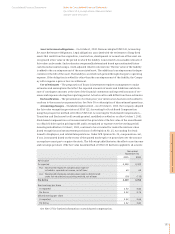Siemens 2005 Annual Report Download - page 148
Download and view the complete annual report
Please find page 148 of the 2005 Siemens annual report below. You can navigate through the pages in the report by either clicking on the pages listed below, or by using the keyword search tool below to find specific information within the annual report.
148
Revenue recognition – Revenue is recognized for product sales when title passes, the risks
and rewards of ownership have been transferred to the customer, the fee is fixed or determinable,
and collection of the related receivable is probable. If product sales are subject to customer accept-
ance, revenues are not recognized until customer acceptance occurs. Revenues from long-term
construction-type projects are generally recognized under the percentage-of-completion method,
based on the percentage of costs to date compared to the total estimated contract costs, contractu-
al milestones or performance. Revenues from service transactions are recognized as services are
performed. For long-term service contracts, revenues are recognized on a straight-line basis over
the term of the contract or, if the performance pattern is other than straight-line, as the services
are provided. Revenue from software arrangements is recognized at the time persuasive evidence
of an arrangement exists, delivery has occurred, the fee is fixed or determinable and collectibility
is probable. Revenue from maintenance, unspecified upgrades or enhancements and technical
support is allocated using the residual value method and is recognized over the period such items
are delivered. If an arrangement to deliver software requires significant production, modifica-
tion, or customization of software, the entire arrangement is accounted for under the percent-
age-of-completion method. Operating lease income for equipment rentals is recognized on a
straight-line basis over the lease term. Interest income from capital leases is recognized using
the interest method.
Sales of goods or services sometimes involve the provision of multiple elements. In these
cases, the Company applies the guidance in Emerging Issues Task Force (EITF) 00-21 Revenue
Arrangements with Multiple Deliverables to determine whether the contract or arrangement
contains more than one unit of accounting. An arrangement is separated if (1) the delivered
element(s) has value to the customer on a stand-alone basis, (2) there is objective and reliable
evidence of the fair value of the undelivered element(s) and (3), if the arrangement includes a
general right of return relative to the delivered element(s), delivery or performance of the unde-
livered element(s) is considered probable and is substantially in the control of the Company. If
all three criteria are fulfilled, the appropriate revenue recognition convention is then applied to
each separate unit of accounting. The total arrangement consideration is allocated to the separate
units of accounting based on each component’s objectively determined fair value, such as sales
prices for the component when it is regularly sold on a stand-alone basis or third-party prices for
similar components. If the three criteria are not met, revenue is deferred until such criteria are
met or until the period in which the last undelivered element is delivered. The amount allocable
to the delivered elements is limited to the amount that is not contingent upon delivery of addi-
tional elements or meeting other specified performance conditions.
Product-related expenses and contract loss provisions – Provisions for estimated costs
related to product warranties are recorded in cost of sales at the time the related sale is recog-
nized, and are established on an individual basis, except for consumer products. The estimates
reflect historic trends of warranty costs, as well as information regarding product failure experi-
enced during construction, installation or testing of products. In the case of new products, expert
opinions and industry data are also taken into consideration in estimating product warranty
accruals. Research and development costs are expensed as incurred. Contract loss provisions are
established in the period when the current estimate of total contract costs exceeds contract revenue.
Earnings per share – Basic earnings per share is computed by dividing net income by the
weighted average shares outstanding during the year. Diluted earnings per share is calculated
by assuming conversion or exercise of all potentially dilutive securities or stock options.
Management’s discussion and analysis
























